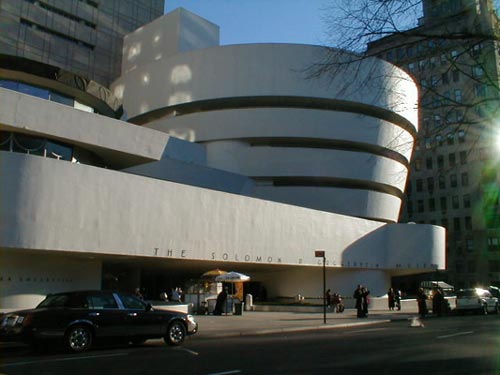Renzo Piano, Stop Playing with My Emotions
The New York Times posted a few articles regarding architecture, the first of which is a review and announcement of an exhibit titled, “Frank Lloyd Wright: From Within Outward," currently on display at the Solomon R. Guggenheim Museum in New York. The museum is celebrating its 50th anniversary and is commemorating the architect who designed it, Frank Lloyd Wright. The article says that, "Taken as a whole, the exhibition conveys not only the remarkable scope of his interests, which ranged from affordable housing to reimagining the American city, but also the astonishing cohesiveness of that vision..."
(Guggeneheim Museum by Frank Lloyd Wright)
As a former Frank Lloyd Wright fanatic, it sounds like an enviable exhibit, but perhaps not as exciting as the opening of the Renzo Piano designed Modern Wing of the Chicago Institute of Art. The article gives the building a favorable review citing that the museum, like other successful projects by Mr. Piano, has a wonderful interplay with light and a strong sense of interior space. Within the context of the city, the building also fits in with neighboring Millennium Park designed by Frank Gehry as well as the museum's original 1893 Beaux Arts structure.(Chicago Art Institute by Renzo Piano)
The one negative point the article makes is in regards to Mr. Piano's style as a whole. "Many of his peers gripe that this is because of the subdued nature of his designs — sophisticated but not too threatening or unfamiliar — which seem tailored to ease the insecurities of museum boards." Mr. Piano, an Italian architect, is having a personal American renaissance designing civic structures all over the country, most notably, "...the renovation of the Morgan Library in Manhattan, a science center in San Francisco and museum additions in Los Angeles, Boston, Chicago and Fort Worth. (He even designed The New York Times Building.)" In an L.A. Times article, which I can't seem to find, an argument is made against Mr. Piano's middle of the road design principles and contends that the ubiquity of said principles in American civic design might lead to a very bland, homogenized architecture, especially in museums.
This fear is further echoed by a nearly unanimous panning of Mr. Piano's recent addition to the Los Angeles County Museum of Art (LACMA). The history of the museum's remodel is long and somewhat infamous (if one is so inclined to follow museum remodel scandals). As the article mentions, LACMA has had a troubled history, architecturally speaking, since it first opened in 1965 when tar started oozing into its fountains. A remodel was commissioned sometime in the 1980's that only further muddled the layout and architectural continuity of the site. In the early 2000's then LACMA president and director, Dr. Andrea Rich, set forth a giant fundraising campaign for yet another LACMA remodel. In 2002, after an international design competition was held, Dutch architect Rem Koolhaas was selected. His plan was to completely raze the current buildings and house the museum's entire collection under one massive glass roof. It was a bold move that most critics agreed was the right choice. However, due to logistical and financial problems the Koolhaas reconstruction was scrapped in favor of a tamer, less expensive remodel by Renzo Piano. In the middle of all this construction buzz, Dr. Andrea Rich stepped down as president and Michael Govan, president and director of the Dia Art Foundation in New York was chosen to be her replacement.
(Proposed LACMA remodel by Rem Koolhaas)
(Broad Contemporary Art Museum by Renzo Piano)
The first phase of the Renzo Piano designed project, the Broad Contemporary Art Museum, financed by home construction mogul and Los Angeles philanthropist Eli Broad, was opened in February 2008 to lukewarm critical reception. As with much of Mr. Piano's work, its interior space was complimented as feeling very open and filled with light and an area in which the art truly was the focus. The outside, however, remains as monolithic as the rest of the museum buildings, especially along Wilshire Blvd. A new entrance pavilion was created, in an attempt to reorient and strengthen the axis of the campus. This proved successful, but the building itself doesn't feel particularly inviting. As noted in a review of the the new building, "Mr. Piano’s design is remarkably uninspired. There is little of the formal freedom that is at the heart of the city’s architectural legacy; nor is there much evidence of the structural refinement that we have come to expect in Mr. Piano’s best work. The museum’s monumental travertine form and lipstick-red exterior stairways are a curious mix of pomposity and pop-culture references. It’s an architecture without conviction."
However, the new building is phase one of the development process. Part two is under construction and includes an amphitheater, a temporary exhibition space, and a plaza filled with palm trees. Sometime in the distant future there are also plans to do something about the existing buildings. What those plans might be and their effectiveness remains to be seen. All eyes are on phase two. Let's home Mr. Piano can dig a little deeper into his imagination and build something fitting for the ever experimental architectural landscape of Los Angeles.
More information and photos of the LACMA addition can be found at dvisible magazine.
For a closer look at Rem Koolhaas's design, check out Arcspace.
An interview with Renzo Piano conducted by Charlie "let-me-interrupt-you-for-the-thousandth-time" Rose can be seen here.




No comments:
Post a Comment